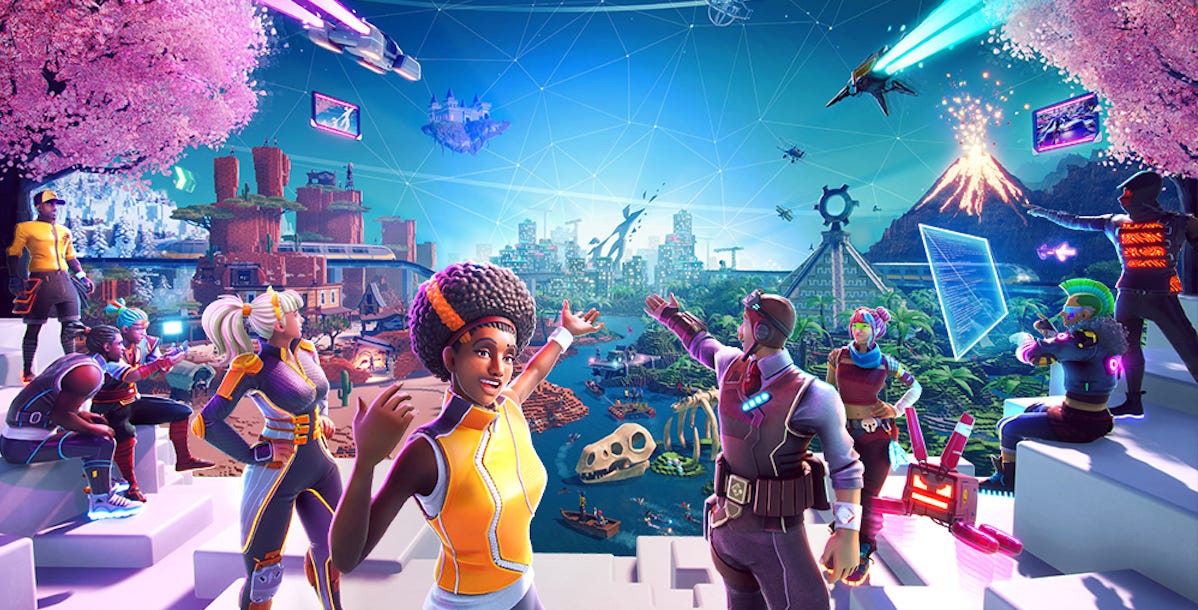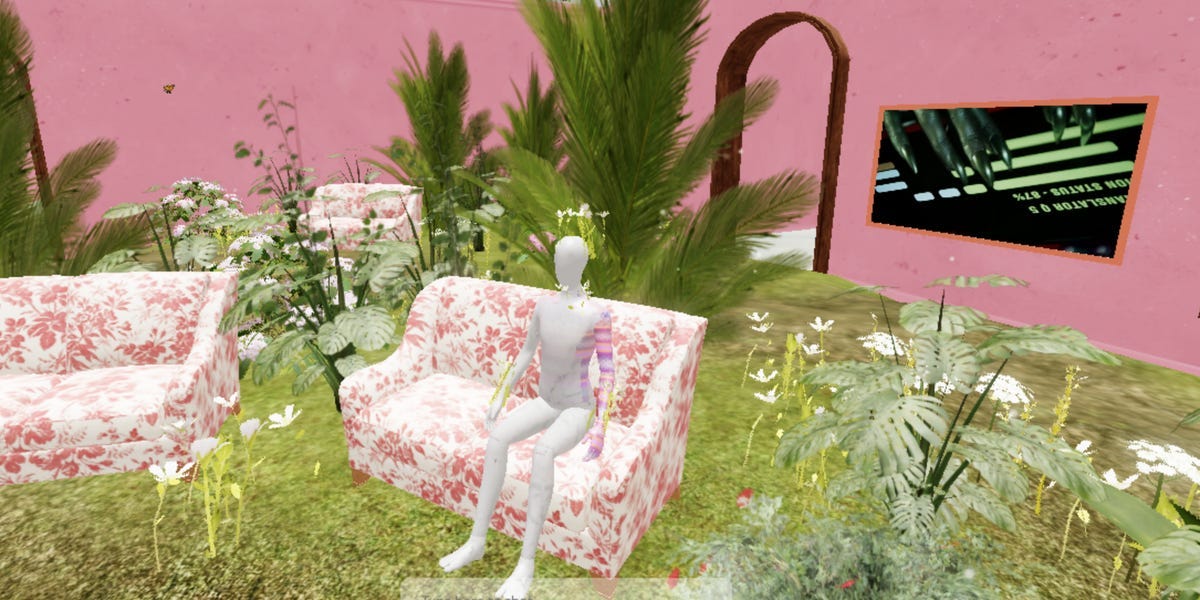The Brand's Guide to the Metaverse
Metaverse bridges, the virtual economy, and a peek into the future.
What is the metaverse?
Between my fascination with the concept and the brightest minds across the world diving headfirst into the "metaverse", I have started to develop a framework and guide for brands to use to plan and execute initiatives that lead them into this "futuristic" world. But first, we must understand what this is all about. And understand clearly.
You may be also wondering why this is coming from the Gen Z insights newsletter - here’s why: while the metaverse may be talked about more by others, the first to most readily adopt these new developments is and will continue to be Gen Z. I even believe as a generation, Gen Z is more likely than Gen Alpha to initially adopt these new advances in technology, for reasons you can chat with me about individually.
To begin this exploration, here are a couple of the definitions of the metaverse I believe to be most encompassing:
Kerry Murphy, founder and CEO, The Fabricant
“The metaverse is just a digital layer of our lives. The metaverse will exist once everything that we do digitally is completely, seamlessly connected. So, if I buy a yellow T-shirt in Fortnite, I get to wear it on Instagram, I get to wear it on Facebook, I get to have an AR-wearing experience, and they’re all completely interconnected. The metaverse is just an extension of our physical lives into the digital realm.“
Grant Paterson, head of gaming and esports, Wunderman Thompson
“It’s the creation of a persistent virtual world, in which consumers are able to hop between different virtual experiences. It will be powered by a virtual economy in which there are jobs and the same sort of financial mechanics that we see in typical economies. The idea, as venture capitalist Packy McCormick originally described, is that the metaverse would eventually be the sort of place where, as your virtual avatar, you would be able to go into a Disney store, for example, and buy an outfit for your avatar to wear, then go to a Nikestore and buy a pair of shoes to be delivered to you in the physical world, and then pop into a Spotify or Roblox virtual concert, and then go for a run with all your friends while listening to that concert—a run in the real world, but you’re connected through the metaverse.”
My definition is somewhat similar but more concise and I believe slightly different in its implications, especially for brands:
The metaverse is a world with seamless crossovers between digital and physical worlds, with actions in one having an instantaneous impact in the other. The metaverse is omnipresent, a persistent and continual world where you can both be sleeping in one life and awake in another; with both having simultaneous and real consequences. It is a world fueled by the same fundamental desires we see across humanity today; belonging, status, and the desire to control and construct your identity.
In order for this world to be fully developed, it must follow two fundamental laws, one of which is currently in place and the other we are far from:
Interoperability
The idea that identities, experiences, and possessions can travel and remain unchanged across platforms and worlds.
Persistence
Life in both virtual and physical worlds continues unstopped.
Persistence and interoperability both function in our current physical world. Traveling from the US to Europe allows you to maintain who you are and what you own. When you sleep at night and wake up in the morning, life still happened in those (ideally) 8 hours you slept.
In the virtual world, persistence exists in some places, yet interoperability does not anywhere. I like to think of persistence like a game of Farmville - you leave for a week, and you come back on the app with dying crops and much to harvest. Time passed just as it did in the physical world. And in some games and on some platforms, this same persistence exists. It has yet to reach the worlds of Fortnite and Roblox.
Interoperability, on the other hand, we are far from. This is the idea that Kerry Murphy proposes, in that your yellow shirt purchased in Fortnite you can wear in Roblox and on Snapchat.
But why are we so far from this? In order for this to happen, we must adopt a universal avatar. There must be a commonly accepted basic "identity". And truth is, I believe every company knows that this is the key. Fortnite will never let a Roblox avatar play its game, and Roblox will never let you enter with your Fortnite avatar. So how will we achieve interoperability?
Truthfully I'm not sure. And I'm not sure we ever will, to the extent or meaning that the term suggests now. The world’s most powerful companies, Facebook, Epic Games, Tencent, etc, are all trying to build this world and control as much of it as they can. And none of them will be willing to relinquish control to the one thing that makes it possible.
What else is important to understand for brands?
The metaverse will be powered by a virtual economy. As Packy McCormick suggests, there will be jobs and the same sort of financial mechanics that we see in typical economies. Don Stein, founder of Roomkey, shares "There is a virtual economy which powers activity on the platform, and each person feels compelled to customize their avatar and space".
The virtual economy is essential for brands to understand, and perhaps it can be best portrayed through understanding what makes up the concept of an economy in the "real world". Investopedia describes it as: "An economy encompasses all activity related to production, consumption, and trade of goods and services in an area."
In the metaverse, this means the introduction of two fundamental building blocks: blockchain and user-generated content. Blockchain is powering these transactions, fueling a way for virtual goods and services to be produced, consumed, and traded. Early on, we're seeing this through the manifestation of NFT's. User-generated content is important here because this is how many of these goods and services are produced. People like you and me are able to create games, create clothes, artwork, etc., and sell them to consumers.
So if the everyday person plays a role in stimulating the virtual economy, what is the role of a company or brand?
The role of brand in the virtual world
There are two main differences between a brand and an everyday user in this world:
Resources
The value of brand
Companies have access to the top talent across the world to develop and create virtual games, currencies, and even virtual jobs within these games. I like to point to the development of Vans World in Roblox as a good example of this - Vans and Roblox worked together to create this world and distribute it to the masses, something that could not be done by a random user. The second difference comes in the form of brand value; when Gucci develops an NFT purse and sells it, it is going to be much more valuable than a virtual purse I personally develop. No matter how fashionable or cool it is.
The ultimate goal of a brand in the metaverse is to add value in both the physical and digital worlds. But this looks a lot different for different types of brands. Gucci, to continue the previous example, can create luxury goods in the virtual and physical worlds, the former carrying an equivalent (if not) greater value. Evidence: a digital-only Gucci bag sold for $4,000 in June 2021 in Roblox. And this makes sense - Gucci is a clothing brand, and we expect them to specialize in this area of virtual possessions as a bridge between the physical and digital worlds that adds value to their brand.
Starbucks, on the other hand, is in a different situation. You can not drink a virtual Starbucks and enjoy it in the same way you would in real life. Starbucks needs a bridge between digital and physical that ends with a real cup of Starbucks coffee in your hands. Should Starbucks then just focus on virtual possessions and forget the metaverse as a way to add true brand value and just focus on capitalizing on Starbucks fandoms through virtual possessions? Perhaps. But perhaps not. Maybe they should focus on creating experiences that reflect the Starbucks brand and encourage people to go to their stores in real life. Or perhaps they should focus on playing a role in facilitating or creating social interactions, just like the origin behind the creation of the coffee house as a place to spread ideas and bring people together. Or perhaps there's a different way to create real-world Starbucks consumption from digital action.
It is possible for Starbucks to focus on experiences and also create possessions. It is also possible for Gucci to focus on possessions and also create experiences as they did with the virtual Gucci garden in Roblox. But each brand must be cautious - it is just as easy to build brand value through these different bridges as it is to dilute it.
Identify your brand's metaverse bridge
Every brand must leverage and focus on one of these bridges as a way to build true brand value. As I mentioned earlier, this is not to say Gucci can not create virtual experiences - but recognizing and prioritizing the true goal of virtual possessions is essential for the way those experiences must be shaped. Vans did the same with Vans World - creating an experience to focus on the possessions, both virtual and physical.
Brand metaverse bridges:
Virtual economy
Virtual jobs, currencies, marketplaces…
Virtual possessions
Virtual clothing, accessories, cars…
Virtual experiences
Virtual concerts, games, live events…
Virtual social interactions
Virtual meetups, clubs, dates…
Which bridge between digital and physical worlds will increase your brand’s value? And which ones will dilute it?
Thanks for reading! This is just the beginning of our work in the metaverse. There is much, much more to come.









